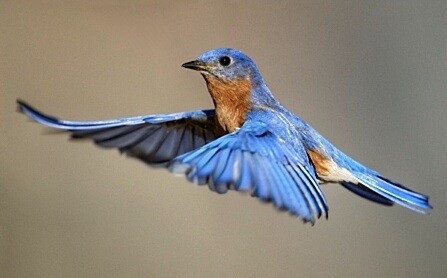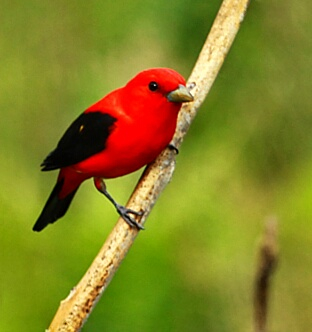The Eastern Bluebird is the only bluebird species found in New England. Mountain and Western Bluebirds are found west of the prairie states. The male Eastern Bluebird has a bright blue back and reddish-brown breast, sides, and flanks. The underparts are white. The coloration of the female is similar, although paler and more muted than that of the male. Juvenile bluebirds are grayish, with brown and white spots on the back and breast only the wings and tail show any blue.

It is one of the most loved and beneficial birds, declined in numbers from the late 1800s through the 1980s. One significant contributing factor to this decline was the lack of suitable nesting cavities needed by the bluebird to successfully raise young. This lack of nesting cavities resulted from changing land use patterns and increasing urbanization. Competition for nesting cavities from introduced European starlings and house sparrows, the loss of open field habitats, pesticide use, and severe weather conditions have also played a role in the decline of bluebird populations.
The construction of nest boxes and establishment of nest box “trails” in appropriate habitat is helping the bluebird make a comeback. Proper construction and placement of nest boxes will encourage bluebirds and not their alien competitors.

Scarlet Tanagers are a beautifully colored bird. The male’s breeding plumage is red on the body and black on the wings and tail.Scarlet Tanagers are unusual among the 230 species of the Neotropical tanager family because they have seasonal changes in plumage. Despite their bright coloring, sightings of this bird are a rarity. This is because they are found only in the upper canopy of trees where they spend their time moving slowly in search of food. Besides being rarely seen, they are also rarely heard. This is because of the similarity between the Scarlet Tanager and Robin or Rose-breasted Grosbeak calls and songs. Bird watchers with patience and perseverance will, however, find the Scarlet Tanager.
A typical summer sight is a male American Goldfinch flying over a meadow, flashing golden in the sun, calling perchickory as it bounds up and down in flight. In winter, when males and females alike are colored in subtler brown, flocks of goldfinches congregate in weedy fields and at feeders, making musical and plaintive calls.

During mating season the male goldfinch has a bright yellow body, black wings with white stripes, a black cap on its head, and a white rump. Females and winter males have duller feathers that are an olive-yellow color. The male’s black cap may disappear in the winter or turn a dull black. Females don’t have the black cap on their heads. Both males and females have a small cone-shaped bill.

Graceful in flight, musical in its pre-dawn singing, this big swallow is one of our most popular birds. Almost all Purple Martins in the east now nest in birdhouses put up especially for them. Martin housing has a long history: some Native American tribes reportedly hung up hollow gourds around their villages to attract these birds. Purple Martins migrate to South America for the winter, but before leaving, they may gather to roost in groups of thousands in late summer.
Comments
Powered by Facebook Comments
